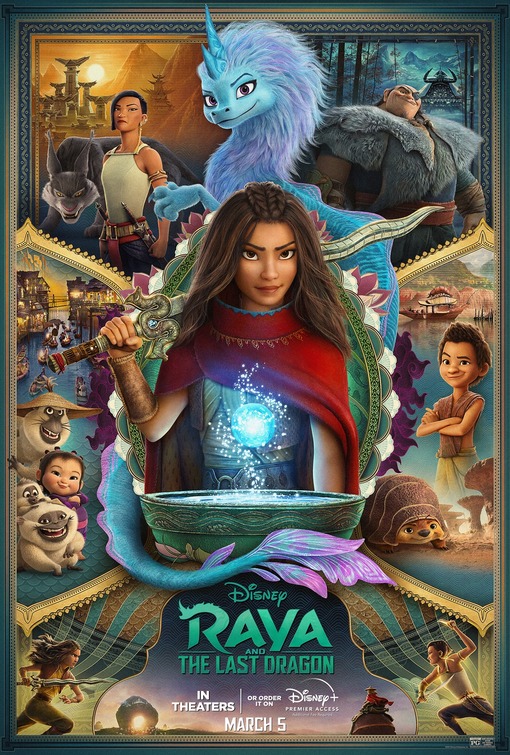
In the mythical land of Kumandra, there lived a fearless and bold warrior princess named Raya (Kelly Marie Tran). And she is not going to be having any sort of a romantic relationship whatsoever, thank you very much. That’s not explicitly stated, but you can rest assured it’s a key part of her personality. Ever since Snow White first appeared in 1937, Disney has always adhered to a blueprint for their leading ladies. Sure it changes with time, but this is the current one. The stars of Frozen and Moana featured fiercely independent types where a romance wasn’t expressed as a desire and now Raya joins that club. That’s perfectly fine since the emphasis is on the adventure, but that trait is now an expected ingredient in the formula.
Formulaic is a good way to describe this convoluted tale. The kingdom of Kumandra is comprised of five tribes named after parts of a dragon: Heart, Fang, Talon, Tail, and Spine. There was a time when a magical gem kept them safe. However, people coveted the object’s power. This further divided their individual societies. Raya’s dad, Chief Benja, (Daniel Dae Kim) guarded the orb. Believing that their warring tribes could still be united, Benja foolishly invites his mortal enemies over for a feast. They (predictably) start fighting over the valuable bauble. It is dropped and shatters into five fragments. The purple smoke-like Druun is unleashed and turns some people into stone. Members from each clan grab the individual pieces and take them back to their respective lands.
It is now six years later. Raya must travel to all 5 lands in Kumandra to retrieve the jewel to restore order. She rides around on her giant pet named Tuk Tuk. The animal functions like an off-road vehicle that looks like an armadillo crossed with a pill bug. Raya is gradually joined one by one “Wizard of Oz style” by a ragtag group of individuals to collect the scattered pieces of the stone. These entities include Sisu (Awkwafina) a goofy water dragon who is the last surviving member of her species, an annoying 10-year-old boy (Izaac Wang), a bulky warrior (Benedict Wong), and a baby thief (Thalia Tran) — who may or may not actually be an infant. I was unclear.
Raya and the Last Dragon may be extremely predictable, but it still curates an environment. Kumandra is a fictional place comprised of an amalgamation of references from different countries to form one monolithic culture. There’s no denying the production team did some homework. They sample from an array of various customs of Southeast Asia — but not solely from any one particular country. It’s sort of a blending of the Philippines, Laos, Indonesia, Thailand, Vietnam, Cambodia, Malaysia, and Singapore. The landscape, food, combat styles, greetings, and objects are fastidiously presented.
Nevertheless, all of the efforts to maintain some credible identity collapses under the A-List Asian cast sporting contemporary American accents. Hearing the hip sassy lingo of suburban teens is fitting on an episode of Modern Family or The Goldbergs, but it’s distracting in a historical period drama set in Southeast Asia. Queens native Awkwafina voices the dragon which is an incongruous creation. Sisu has shapeshifting properties but never manifests as how Westerners know dragons. Sisu is more of a large klutzy furry snake creature that can morph into a human. Her articulation is an amusing contradiction to be sure, but so was Eddie Murphy in Mulan. Regrettably, the voice acting totally takes you out of the atmosphere.
This cartoon is an interesting assortment of talent: written by Qui Nguyen (Netflix TV series The Society) and Adele Lim (Crazy Rich Asians) and directed in an irregular pairing of Carlos López Estrada (Blindspotting) and Don Hall (Big Hero 6). Both directors have done better. I wasn’t particularly charmed by any of the generic situations or personalities. However, the animation is unquestionably stunning and it’s enough to carry you through some of the film’s more insipid passages.
Raya and the Last Dragon is a classic hero’s journey with a strange message. Raya goes on an adventure, is victorious in a crisis, and emerges transformed by the experience. What she learns is an odd lesson though. Her chief antagonist is Namaari (Gemma Chan). On the surface, Raya and Namaari are adversaries, although each woman is more driven by loyalty to their own people than direct hate of the other person. As children, the two were friends, but Namaari betrays Raya’s confidence when she gives her friend a peek at the gemstone. Namaari’s treachery sets the entire thrust of the plot in motion. Despite a history of deception, the movie ultimately pleads that a person should still put faith in their enemy. So if I understand correctly, the moral of the story is an update of a famous proverb. I’m paraphrasing but something along the lines of “Fool me once, fool me twice…it’s all good. I should keep trusting you anyway.” Sounds like dangerous advice.
03-09-21

2 Responses
I think the central tenet of trust here stems from the film’s apparently celebrated timeliness as far as its themes are concerned; from what all I’ve read this has a very specifically post-Trump-era kind of thematic overtone to it, and it reminds me in that way of Zootopia. A movie that explored some fairly heavy concepts but did it in a very colorful way. But Zootopia also kinda irritated me with how it shoved its messages (though good, positive) in my face. It wasn’t a subtle movie. Raya sounds like it ain’t either
I saw one review present the moral as “enemies should set their differences aside for the greater good.” That’s a wonderful thought if both actually do it. It didn’t happen during the prologue of this movie. Sometimes in life, your situation will keep repeating itself until you learn your lesson.